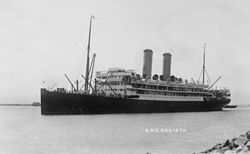Orvieto (ship)
|
||||||||||||||||||||||
|
||||||||||||||||||||||
|
||||||||||||||||||||||
|
||||||||||||||||||||||
|
||||||||||||||||||||||
The Orvieto was a 1909 commissioned passenger ship of the British shipping company Orient Steam Navigation Company , which was used in passenger and mail traffic from Great Britain to Australia . The steamer was decommissioned in 1930 and scrapped in Scotland the following year .
The ship
The 12,133 GRT steamship Orvieto was built at the Workman, Clark & Company shipyard in Belfast and launched on July 6, 1909. The ship, 163.17 meters long and 19.51 meters wide, had two funnels, two masts and two propellers and was powered by steam engines that enabled a speed of 18 knotters. The ship was designed to carry 235 passengers in the first, 186 in the second and 696 in the third class.
The Orvieto had five identical sister ships , all of which were put into service between 1909 and 1911: the Otway (12,077 GRT), the Osterley (12,129 GRT), the Otranto (I) (12,077 GRT), the Orsova (I) (12,136 GRT ) and the Orama (I) (12,927 GRT).
After the takeover on November 6, 1909, the Orvieto left London on November 26, 1909 for her maiden voyage via Suez to Melbourne and Sydney . In 1913, she was the first Orient Line ship to dock at the newly opened New Farm Wharf in Brisbane . To mark the occasion, a banquet was held on the ship, attended, among others, by the Governor of Queensland , Sir William MacGregor and the Prime Minister of Queensland, Digby Denham . On July 3, 1914, the Orvieto left Tilbury under the command of Captain PN Layton for her last voyage in peacetime. When she arrived in Australia, the First World War had already broken out.
War effort
The ship was immediately taken over by the Australian Commonwealth government. In the dry dock in Sydney, the steamer was converted into a troop transport over the next two months and had 91 officers and 1,347 soldiers from the Australian Imperial Force (AIF) on board on its first troop voyage to Egypt . The Orvieto sailed in a convoy of 36 ships , which was secured by ships of the Royal Navy and Japanese destroyers , including the Melbourne and the Sydney . On November 15, 1914, the Orvieto reached Colombo and picked up some crew members of the German cruiser Emden , which had recently been stranded in battle with the Sydney . Among the Germans who fell into captivity were the captain of the Emden ¸ Karl von Müller , and the torpedo officer, Franz Joseph von Hohenzollern-Emden. After the Germans were brought ashore in Suez, the Orvieto continued on to London, where it arrived in January 1915.
Although she was supposed to set sail for Australia on February 12, 1915, the Orvieto was requested by the British Admiralty for use as an Armed Merchant Cruiser and converted accordingly in Millwall. Equipped with eight 6-inch guns, it entered service on March 8, 1916. Command was taken over by Captain H. Smyth of the Royal Navy. On March 21, 1915, she met at Scapa Flow , where she stayed for the next two months. On June 8, she left for Immingham , where she was stationed as a miner for the next ten months and was deployed between Sheerness and Rosyth . On February 18, 1916, the Orvieto was slightly damaged by a collision with the Swedish ship Abiska . 12 days later she ran aground near Sheerness. On April 24, 1916, their guns were used for the first time in an enemy air raid.
At the end of July 1916, the Orvieto was released from this service and assigned to the Northern Patrol . In the next six months, she intercepted over 30 foreign merchant ships and sent them to northern ports to be searched. On February 28, 1917, she collided with a fishing cutter near Mainland , whose chimney and masts broke off due to the force of the collision. In July and August 1917, the Orvieto was overhauled in Hebburn and then returned to the Northern Patrol based in Liverpool. In January 1918 the ship was modernized again at Queen's Dock in Liverpool. During this time, there were repeated minor fires on board the ship. The Orvieto spent the rest of the war as an escort ship on the transatlantic route. In the autumn of 1918 Arthur of Connaught visited the ship in the presence of the Japanese ambassador.
After the war
On November 1, 1919, she resumed her regular passenger traffic from London to Sydney and Brisbane , which she maintained for eleven more years without major incidents. On August 30, 1930 she cast off for her last trip and was then sold for demolition. On April 3, 1931, she arrived in Bo'ness, Scotland, where she was scrapped.
